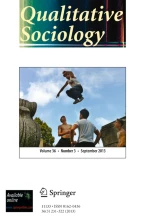Abstract
Using grounded theory as an example, this paper examines three methodological questions that are generally applicable to all qualitative methods. How should the usual scientific canons be reinterpreted for qualitative research? How should researchers report the procedures and canons used in their research? What evaluative criteria should be used in judging the research products? We propose that the criteria should be adapted to fit the procedures of the method. We demonstrate how this can be done for grounded theory and suggest criteria for evaluating studies following this approach. We argue that other qualitative researchers might be similarly specific about their procedures and evaluative criteria.
Similar content being viewed by others
References
Agar, M. (1986). Speaking of Ethnography. Beverly Hills CA: Sage.
Barley, S. (1986). “Technology as an occasion for structuring” evidence from observations of CT scanners and the social order of radiology departments.”Administrative Science Quarterly 31, 78–108.
Becker, H. (1970). Sociological Work: Method and Substance. New Brunswick, N.J.: Transaction.
Blumer, H. (1931). “Science without concepts.”American Journal of Sociology 36, 515–533.
Burgess, R. (ed.) (1982).Field Research: A Source Book and Field Manual. London: George Allen and Unwin.
Charmaz, K. (1983). “The Grounded Theory Method: An Explication and Interpretation.” In R. Emerson (ed.)Contemporary Field Research. Boston: Little, Brown & Co. 109–126.
Dewey, J. (1916).Essays in Experimental Logic. Chicago: University of Chicago.
Dewey, J. (1925). Experience and Nature Chicago: Open Court. Fielding, N. and Fielding J. 1986.Linking Data. Beverly Hills, CA.: Sage.
Glaser, B. (1978).Theoretical Sensitivity. Mill Valley, CA: Sociology Press.
Glaser, B., and Strauss, A. (1967). The Discovery of Grounded Theory. Chicago: Aldine.
Gortner, S., and Schultz, P. (1988). “Approaches to nursing science methods.”Image 20, 22–23.
Hammersley, M., and Atkinson, P. (1983).Ethnography: Principles in Practice. London: Tavistock.
Hughes, E. (1971).The Sociological Eye. Chicago: Aldine, 1971. Reprinted, New Brunswick, New Jersey: Transaction, 1987.
Johnson, J. (1975).Doing Field Research. N.Y.: Free Press.
Kidder, L. (1981). “Qualitative research and quasi-experimental frameworks.” In M. Brewer and B. Collings (eds.).Scientific Inquiry and the Social Sciences. San Francisco: CA: Jossey-Bass.
Kirk, J. and Miller, M. (1986).Reliability, Validity and Qualitative Research. Beverly Hills, CA: Sage.
Kuhn, T. (1962).The Structure of Scientific Revolutions. Chicago: University of Chicago.
Le Compte, N., and Goetz, J. (1982). “Problems of reliability and validity in ethnographic research.”Review of Educational Research 52, 31–60.
Mead, George H. (1934).Mind, Self, and Society. Chicago: University of Chicago.
Park, R., and Burgess, E. (1921).An Introduction to the Science of Sociology. Chicago: University of Chicago.
Popper, K. (1959).The Logic of Scientific Discovery. N.Y.: Basic Books.
Sandelowski, M. (1986). “The problem of rigor in qualitative research.”Advances in Nursing Science.8, 27–37.
Strauss, A. (1970). “Discovering New Theory from Previous Theory.” In T. Shibutani (ed.)Human Nature and Collective Theory. Englewood Cliffs, N.J.: Prentice-Hall.
Strauss, A. (1987).Qualitative Analysis. N.Y.: Cambridge University Press.
Strauss, A. and Corbin, J. (1990).Basic of Grounded Theory Methods. Beverly Hills, CA.: Sage.
Strauss, A., and Corbin, J. (1989). “Tracing Lines of Conditional Influence: Matrix and Paths.” Paper delivered at the annual meetings of the American Sociological Society, San Francisco, California, August 13.
Strauss, A., Fagerhaugh, S., Suczek, B., and Wiener, C. (1985).The Social Organization of Medical Work. Chicago: University of Chicago.
Author information
Authors and Affiliations
Rights and permissions
About this article
Cite this article
Corbin, J.M., Strauss, A. Grounded theory research: Procedures, canons, and evaluative criteria. Qual Sociol 13, 3–21 (1990). https://doi.org/10.1007/BF00988593
Issue Date:
DOI: https://doi.org/10.1007/BF00988593
